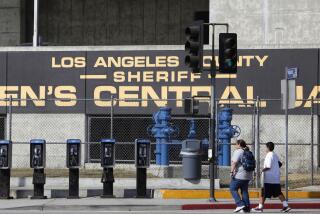Plea for ‘Caller Pays’ System Falls on Deaf Ears
- Share via
For all their conveniences and fancy new features, wireless phones in this country still come with a fundamental flaw: a billing system that charges users for every call, whether initiated or received.
Earlier this year, federal regulators seemed set to rectify that inequity by adopting a “calling party pays” system that would more closely mirror the way traditional wired calls are charged.
But after talking up the proposal for months, the Federal Communications Commission deadlocked on the issue and in February abruptly shelved the plan--perhaps for good.
That’s because as appealing as they may sound to frequent mobile phone users and those on limited budgets, schemes that make callers pay the toll have their own drawbacks. Those pitfalls, as well as the sticky issue of how to bill inbound callers who aren’t customers, have left FCC officials less willing to press the matter.
Consumer groups and state regulators have pushed the FCC to include stringent notification requirements and other consumer protections. Without them, they argue, the switch to “caller-pays” would saddle unwitting callers with per-minute prices well above prevailing land-line rates.
A long list of colleges also opposes the measure because the main number for campuswide phone systems would show up as the billable party for calls to mobile phones, and the universities would have no way to identify individual callers to pass on added costs.
In addition, consumer groups and universities point out that current caller-pays proposals offer no mechanism for disabling such calls the way 900 and other higher-priced calls can be blocked.
“We think [caller-pays] could be an extraordinary headache for consumers,” said David Butler, a spokesman for Consumers Union, which opposes any plan without detailed price disclosures. “We haven’t seen any proposal that would tell consumers, reliably, how much they would be paying for the call.”
For years, U.S. mobile phone companies have lobbied for a caller-pays system, arguing that it spurs the popularity of wireless by encouraging users to leave their phones on and to give out their mobile phone numbers more freely.
Indeed, much of the rest of the world adheres to that billing method, and backers say the feature has helped those nations achieve higher cell phone usage and penetration than in the United States.
Now, however, even mobile phone carriers are not so sure they want--or need--a national caller-pays model to boost the industry. That’s especially true if the FCC approves a plan with rigid notification requirements that could scare callers into hanging up.
In truth, the perceived need for caller-pays in this country is fading fast. With the addition of new mobile competitors and a variety of lower-cost pricing plans, the U.S. wireless industry is signing up customers so fast that capacity has become an issue in many regions.
Many of those new offerings already ease the cost of incoming calls for mobile users. Sprint PCS and several other carriers waive the charge for the first minute of all incoming calls, and Nextel Communications has experimented with a promotion that makes incoming calls free through the end of 2001.
In addition, mobile customers have embraced the widespread introduction of so-called big-bucket wireless calling plans, which include--for a flat monthly fee--a set number of total minutes to use each month for both incoming and outgoing calls. Carriers say few customers exceed their monthly allotment, and that fact alone is chipping away at customers’ resistance to incoming calls.
Certainly, the surging public backlash against ringing cell phones in restaurants and at movies and public events is strong evidence that large numbers of customers are leaving their phones on--and happily accepting inbound calls wherever they are.
“It does appear that with prices coming down substantially, and people buying in buckets, they no longer think of the taxi meter each time they answer their [wireless] phone,” said John Zeglis, president of AT&T; and chairman and chief executive of AT&T;’s wireless services unit. “So the distressing effect is not here anymore. And you’ve got caller ID so you can see who is coming in.”
There also is growing evidence that U.S. consumers don’t want to change to the caller-pays system. Several wireless companies have launched limited caller-pays plans in areas around the country, but analysts say none of them have taken off.
Verizon Wireless (formerly AirTouch Cellular), a longtime caller-pays proponent, has all but given up on it for the moment.
The company made a splash by launching caller-pays plans years ago in seven states, but now only sells the service on request. The plan costs an extra $3.95 for the customer, and callers to the customer’s phone pay between 39 cents and 45 cents per minute.
For four months this summer, Verizon tried a more flexible version in Seattle, where customers could turn the caller-pays feature on and off and could exempt certain callers from the charges. But Verizon halted the test plan at the end of June, and the company has not said what plans, if any, it has to press ahead with caller-pays.
Last year, AT&T; Wireless tested a caller-pays plan in Minneapolis that used a special area code to distinguish the phone numbers for callers. The company scratched plans for a national roll-out. Analysts said AT&T;’s trial offering attracted fewer than 100 customers.
Consumers are obviously wary. A limited 1998 survey by the Yankee Group research firm found that 77% of general users surveyed said they would be “not at all willing” or “not very willing” to pay for calls to a wireless phone or pager.
Marc Schuette counts himself among those resisting caller-pays.
Schuette manages the communications and computer networks for Consolidated Supply Co., an Oregon-based plumbing and waterworks supplier. After noticing strange new charges on phone bills for the firm’s Idaho branch, Schuette discovered the company was being billed for employee calls to clients who had caller-pays mobile phone plans.
“The thing that teed me off about it was that I had no choice, there was no way to control it,” he said. “The rates were anywhere from about 22 to 30 cents per minute. No one is paying 25 cents a minute these days. . . . We negotiate with our carriers and our plans are down to 5 cents a minute.”
Although the charges so far have amounted to just a trickle, Schuette worries the problem could grow if caller-pays plans become more widespread. He wrote a letter to FCC officials urging them not to allow nationwide caller-pays plans.
Even cell phone users themselves--arguably the folks with the most at stake, because they pay for the calls--seem ambivalent. In a 1999 survey by research firm Cahners In-Stat Group, users said they were most interested in the caller ID feature for wireless phones and ranked caller-pays second-to-last as a desirable feature.
Even those who like the idea of caller-pays may be reluctant to sign up, fearing that reversing the charges may turn off or offend clients and customers who try to reach them on their mobile phones.
For those reasons and many others, most industry watchers believe the FCC will not resurrect the caller-pays proposal. FCC officials declined to comment on the issue because it is still pending before the commission.
“A year ago, there was a drumbeat to initiate calling party pays, but it’s now just kind of faded away,” said Ken Hyers, a wireless analyst at Cahners In-Stat Group. “Prices have dropped so much that it just doesn’t matter anymore.”
(BEGIN TEXT OF INFOBOX / INFOGRAPHIC)
Wireless Wishes
Unlike conventional phone service, cell phone users in the U.S. are charged for calls they both make and receive. Now federal officials are weighing a move to a “calling party pays” system, which would require people calling mobile phones to pay the charges instead of the recipient. But with cell phone usage prices falling, and customers getting big allotments of minutes to use each month, consumer consider “calling party pays” a very low priority.
(Feature: Percentage expressing interest in feature*)
Caller ID: 19%
Voice-activated dialing: 18%
Follow-me numbers: 15%
Voicemail: 13%
Mobile-to-mobile calling: 13%
Call forwarding: 12%
Call waiting: 11%
No answer / busy transfer: 9%
Access to information **: 9%
Three-way / Conference calling: 8%
Group call: 8%
Calling party pays: 8%
Prepaid service: 5%
* Results of May 1999 survey of more than 300 people who use cell phones for business
** Such as weather and traffic
Source: Cahners In-Stat Group






